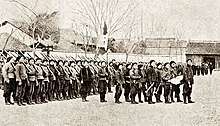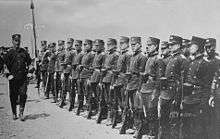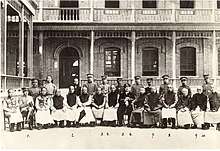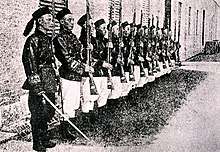New Army
The New Armies (Traditional Chinese: 新軍, Simplified Chinese: 新军; Pinyin: Xīnjūn, Manchu: Ice cooha), more fully called the Newly Created Army (新建陸軍 Xinjian Lujun[lower-alpha 1][lower-alpha 2]), was the modernized army corps formed under the Qing dynasty in December 1895, following its defeat in the First Sino-Japanese War. It was envisioned as militia fully trained and equipped according to Western standards.
| New Army | |
|---|---|
| 新軍 | |
.svg.png) Flag of the Qing dynasty | |
| Active | 1895–1912 |
| Country | |
| Allegiance | |
| Engagements |
|
| Commanders | |
| Notable commanders | Yuan Shikai |
| Insignia | |
| Flag of China (1889–1912) | .svg.png) |
Formation and expansion

There was a forerunner to the effort of modernizing the Chinese army, created before the end of the Sino-Japanese War: in February 1895, the Qing court assembled its Dingwu or the Pacification Army (定武軍 Dingwu jun), consisting of 10 battalions or ying (営), totaling 4,750 men. This was initially organized by Hu Yufen aided by German advisor Constantin von Hanneken[1][2][lower-alpha 3]
The command of this Pacification Army was turned over to Yuan Shikai by mid-December 1895,[3][lower-alpha 4][lower-alpha 5] and within a few months[4] was renamed the Newly Created Army (新建陸軍 Xinjian Lujun) and expanded to 7,000 men.[1][3] (Yuan's Newly Created Army was later to become the Guards Army's Right Division (Wuwei Youjun).[3][5])
The Newly Created Army (or simply the New Army) that was 7,000 men strong then became the most formidable of the three army groups stationed near Beijing and proved effective against the Boxers in Shandong province. Yuan refused to obey the Imperial Court's orders to halt his suppression of the Boxers when the Eight-Nation Alliance invaded China during the rebellion and refused to obey orders to fight the alliance.
The New Army was gradually expanded and upgraded in the following years. Yuan became increasingly disrespectful of the dynasty and only loyal to the party from which he benefited; his defection to Cixi against the Guangxu Emperor was a major blow to the Hundred Days' Reform. After 1900, Yuan's troops were the only militia that the Qing court could rely on amidst revolutionary uprisings throughout China.
Renaming and revolution
The Manchu Division moves with the Court, and is the pride of the modern army.
By his strategic disposition Yuan Shi Kai completely controls all the approaches to the capital, and holds a force which he may utilize either to protect the Court from threatened attack or to crush the Emperor should he himself desire to assume Imperial power. Contrary to treaty stipulations made at the settlement of the Boxer trouble, the Chinese have been permitted to build a great tower over the Chien Men, or central southern gate, which commands the foreign legations and governs the Forbidden City. In the threatening condition of Chinese affairs it might be assumed that this structure had been undermined by the foreign community, but this has not been done, and if trouble again arise in Peking the fate of the legations will depend upon the success of the first assault which will be necessary to take it. The foreign legations are as much in the power of Yuan Shi Kai's troops in 1907 as they were at the mercy of the Chinese rabble in 1900.
The ultimate purpose of the equipped and disciplined troops is locked in the breast of the Viceroy of Chihli. Yuan Shi Kai's yamen in Tientsin is connected by telegraph and telephone with the Imperial palaces and with the various barracks of his troops. In a field a couple of hundred yards away is the long pole of a wireless telegraph station, from which he can send the message that any day may set all China ablaze.To-morrow in the East, Douglas Story, pp. 224-226[6]
The Chien Men gate refers to the Zhengyangmen.
The successful example of the new army was followed in other provinces. The New Army of Yuan was renamed the Beiyang Army on June 25, 1902 after Yuan was officially promoted to the "Minister of Beiyang". By the end of the dynasty in 1911, most provinces had established sizable new armies; however, Yuan's army was still most powerful, comprising six groups and numbering more than 75,000 men. The Qing unified all of China's armies into one force, the "Chinese Army", which was commonly still called the New Army. Two-thirds of the Chinese Army was Yuan's Beiyang Army.
During the Xinhai Revolution, most of the non-Beiyang forces as well as some Beiyang units in the Chinese Army revolted against the Qing. Yuan led the Beiyang Army into opposing the revolution while also negotiating for the Qing's surrender and his ascendency to the presidency of the new republic.
Politics and modernization

Yuan kept a tight grip on the command of the army after its establishment by installing officials only loyal to him; however, after his death in 1916, the army groups were quickly fragmented into four major forces of combative warlords, according to the locations of garrisons. These army groups and generals played different roles in the politics of the Republic of China until the establishment of the People's Republic of China following the Communist Party of China's victory in the Chinese Civil War.
One of the most important legacies of the New Army was the professionalization of the military and perhaps introduction of militarism to China. Previously, almost any male could join and soldiers were mostly poor, landless and illiterate peasants. The New Armies moved beyond the personalized recruitment and patronage of Zeng Guofan and Zuo Zongtang, which had been successful in the mid-century uprisings, but seemed discredited in the face of modern armies in Japan and the West. The New Army began screening volunteers and created modern military academies to train officers. The modernization and professionalization of the New Army impressed many in the gentry class to join. The young Chiang Kai-shek, for instance, briefly attended Yuan's Baoding Military Academy, which thus influenced him in forming his Whampoa Academy, which trained a succeeding generation of soldiers. Yuan and his successors equated military dominance of the political sphere with national survival. The political army would become a dominant force in China for much of the twentieth century.
 Qing soldiers of a New Army unit in 1905.
Qing soldiers of a New Army unit in 1905. New Army officers in Wuchang in 1906
New Army officers in Wuchang in 1906 Qing New Army manoeuvres
Qing New Army manoeuvres Qing New Army manoeuvres
Qing New Army manoeuvres Qing New Army in 1911
Qing New Army in 1911 Qing New Army in Chengdu in 1911
Qing New Army in Chengdu in 1911 Qing officers training
Qing officers training New Army officers
New Army officers New Army officers
New Army officers New Army in 1910
New Army in 1910 Cavalry of the Qing New Army
Cavalry of the Qing New Army Chinese medics of the Qing New Army
Chinese medics of the Qing New Army
Notable figures of Beiyang

- Yuan Shikai (袁世凱)
- Duan Qirui (段祺瑞)
- Wang Yingkai (王英楷)
- Wu Peifu (吳佩孚)
- Feng Guozhang (馮國璋)
- Sun Chuanfang (孫傳芳)
- Xu Shichang (徐世昌)
- Wang Shizhen (王士珍)
- Cao Kun (曹錕)
- Zhang Xun (張勳)
- Feng Yuxiang (馮玉祥)
- Lu Yongxiang (盧永祥)
- Xu Shuzheng (徐樹錚)
- Zhang Zhizhong (張治中)
- Song Zheyuan (宋哲元)
- Tang Shengzhi (唐生智)
- Qin Dechun (秦德純)
- Qi Xieyuan (齊燮元)
See also
Explanatory notes
- Chinese: 新建陸軍; pinyin: Xīnjìan Lùjūn; Wade–Giles: Hsin-chien lu-chün
- Also translated as "Newly Established Army" (Chi 1976, p. 13)
- As to the man-count figures, "3000 infantrymen, 1000 artillery men, 250 cavalry men, and 500 engineers, a total of 4750 men" is given by Chien-Nung Li,[2] although "more than five thousand men" is given by Wang 1995, pp. 69. If engineers are excluded as non-combatants the figure may round down to 4,000, as given by Chi 1976, p. 13.
- On December 8, 1895, Empress Dowager Cixi passed down the edict
- Yuan was at this time the taotai or intendant of several provinces.
References
Citations
- Wang 1995, pp. 69
- Li 1956, p. 184
- Purcell 2010, p. 28
- Chi 1976, p. 13
- Wang 1995, pp. 71, quote:"In May 1899, Yuan Shikai, commander of China's strongest army, the Wuwei Youjun or the Right Division (new name for Yuan's Newly Created Army) of the Guards Army [Note: The Guards Army or Wuwei Jun included Left, Right, Front, Rear, and Center Divisions]"
- Story, Douglas (1907). To-morrow in the East. G. Bell & Sons. pp. 224–226. Retrieved 1 April 2013.
Sources
- Chi, Hsi-sheng (1976). Warlord Politics in China: 1916-1928 (preview). Stanford University Press. p. 13. ISBN 978-0-804-76619-7.
- Fung, Allen (1996). "Testing the Self-Strengthening: The Chinese Army in the Sino-Japanese War of 1894-1895". Modern Asian Studies. 30 (4): 1007–1031. doi:10.1017/s0026749x00016875. JSTOR 312957.
- Fung, Edmund S. K. (1980). The Military Dimension of the Chinese Revolution : The New Army and Its Role in the Revolution of 1911. Vancouver: University of British Columbia Press.
- Li, Chien-Nung (1956). Ssù Yü Têng; Jeremy Ingalls (eds.). The Political History of China,1840-1928 (preview). Stanford University Press. pp. 102–103. ISBN 978-0-804-70602-5.
- Powell, Ralph L. (1972) [1955]. The Rise of Chinese Military Power 1895-1912 (snippet). Princeton: Kennikat Press. pp. 102–103.
- (originally published: Princeton, N.J., Princeton University Press, 1955)
- Purcell, Victor (2010). The Boxer Uprising: A Background Study (preview). Cambridge University Press. p. 29. ISBN 978-0-521-14812-2.
- Wang, Jianhua (Spring–Summer 1995). "Military Reforms, 1895-1908" (snippet). Chinese Studies in History. 28 (3–4): 67–84. doi:10.2753/CSH0009-463328030467. abstract
- Reprinted in: Reynolds, Douglas R., ed. (1995). China, 1895-1912 State Sponsored Reforms and China's Late-Qing (preview). M.E. Sharpe. pp. 67–84. ISBN 978-1-563-24749-1.
